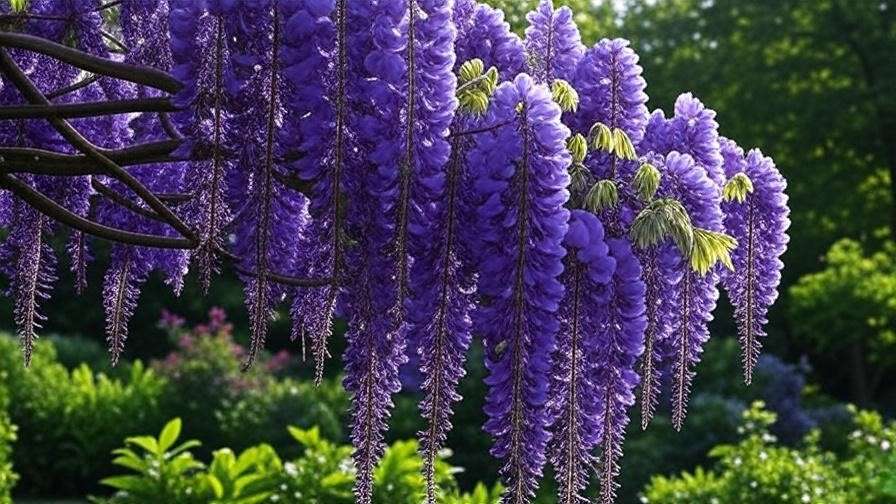Imagine your garden transformed into a dreamy oasis, with cascades of vibrant purple-blue flowers draping elegantly from a majestic blue wisteria tree. This breathtaking plant, known for its show-stopping blooms, is a favorite among gardeners seeking to elevate their outdoor spaces. Whether you’re a seasoned horticulturist or a beginner with a passion for plants, growing and caring for a blue wisteria tree can be a rewarding journey. In this comprehensive guide, we’ll share expert-driven, actionable tips to help you cultivate a thriving wisteria tree that bursts with color year after year. Backed by years of horticultural expertise, this article will empower you to overcome common challenges and achieve a stunning, healthy blue wisteria tree that becomes the centerpiece of your garden. 🌺
What Is a Blue Wisteria Tree? 🌳
Overview of the Blue Wisteria Tree
The blue wisteria tree, often derived from Wisteria sinensis or related cultivars, is a woody vine trained into a tree form, celebrated for its cascading clusters of fragrant, purple-blue flowers. Native to East Asia, particularly China, this ornamental plant blooms in spring, creating a romantic, picturesque display. Its ability to adapt to various settings—gardens, patios, or pergolas—makes it a versatile choice for plant enthusiasts. The blue wisteria tree typically grows 10-25 feet tall when trained, with glossy green leaves and a sturdy trunk that adds structural beauty to landscapes. 🌼
Types of Blue Wisteria Trees
Several cultivars offer unique traits to suit different climates and preferences:
- ‘Blue Moon’: A cold-hardy variety (down to Zone 4) with prolific blooms, ideal for northern gardens.
- ‘Amethyst Falls’: A compact, less invasive cultivar perfect for smaller spaces or containers.
- ‘Prolific’: Known for abundant flowers and faster blooming, even in young plants.
While wisteria naturally grows as a vine, it can be trained into a tree through careful pruning and support. Choosing the right cultivar depends on your climate, available space, and aesthetic goals. For example, ‘Amethyst Falls’ thrives in urban gardens, while ‘Blue Moon’ suits colder regions. 🌱
Why Grow a Blue Wisteria Tree? 🌸
Benefits of Blue Wisteria Trees
A blue wisteria tree is more than just a pretty face. Its benefits include:
- Aesthetic Appeal: The cascading blooms create a fairy-tale-like atmosphere, perfect for romantic or serene gardens.
- Pollinator Attraction: Bees and butterflies flock to its nectar-rich flowers, boosting local biodiversity. 🐝
- Versatility: It thrives in various settings, from standalone trees to arbor coverings or patio focal points.
- Shade and Privacy: Mature wisteria trees provide ample shade, ideal for outdoor relaxation.
Common Challenges and Solutions
Despite its beauty, the blue wisteria tree can present challenges:
- Invasiveness: Its vigorous growth can overtake nearby plants. Solution: Regular pruning and root barriers.
- Slow Blooming: Young trees may take 3-5 years to flower. Solution: Proper fertilization and patience.
- Maintenance: Requires consistent care. Solution: Follow a structured care plan, as outlined below.
With the right approach, these challenges are manageable, making the blue wisteria tree a worthwhile addition to any garden. 🌿
Step-by-Step Guide to Growing a Blue Wisteria Tree 🌱
Choosing the Right Location
Location is critical for a thriving blue wisteria tree. Here’s what to consider:
- Sunlight: Wisteria needs at least 6 hours of direct sunlight daily to produce abundant blooms. A south-facing spot is ideal.
- Space: Ensure enough room for the tree’s canopy (up to 15-20 feet wide) and deep roots. Avoid planting near structures that roots could damage.
- Climate: Most cultivars thrive in USDA Hardiness Zones 5-9. Check your zone and select a variety like ‘Blue Moon’ for colder climates.
Soil Preparation and Planting
Healthy soil sets the foundation for a vibrant wisteria tree:
- Soil Type: Wisteria prefers well-draining, loamy soil with a pH of 6.0-7.0 (slightly acidic to neutral).
- Preparation: Test soil drainage by digging a 12-inch hole, filling it with water, and ensuring it drains within a few hours. Amend with compost or organic matter to improve fertility.
- Planting Process:
- Dig a hole twice as wide and as deep as the root ball.
- Place the tree, ensuring the root crown is level with the soil surface.
- Backfill with a mix of native soil and compost, then water thoroughly.
- Add a 2-3 inch layer of mulch to retain moisture and regulate soil temperature.
Training a Wisteria Vine into a Tree
Transforming a wisteria vine into a tree requires patience and precision:
- Tools Needed: Sturdy stake (6-8 feet tall), soft plant ties, and sharp pruning shears.
- Training Steps:
- Select a strong, central stem as the “leader” to form the trunk.
- Secure the leader to the stake with ties, keeping it straight.
- Remove side shoots below the desired canopy height (typically 4-6 feet).
- Allow upper branches to form the canopy, pruning to maintain shape.
- Timeline: Training takes 2-3 years, with regular pruning to reinforce the tree structure.

Essential Care Tips for a Thriving Blue Wisteria Tree 🌿
Watering Needs
Proper watering ensures a healthy wisteria tree:
- Establishment Phase (First Year): Water deeply 1-2 times per week, providing 1-2 gallons per session.
- Mature Trees: Water every 10-14 days during dry spells, ensuring soil stays moist but not waterlogged.
- Seasonal Adjustments: Increase watering in summer heat; reduce in fall and winter when the tree is dormant.
Fertilizing for Vibrant Blooms
Fertilization promotes lush foliage and prolific flowers:
- Best Fertilizer: Use a low-nitrogen, high-phosphorus fertilizer (e.g., 5-10-10) to encourage blooming over leafy growth.
- Schedule: Apply in early spring before bud break and again in mid-summer after flowering.
- Expert Tip: Avoid high-nitrogen fertilizers, as they promote foliage at the expense of blooms. Conduct a soil test to confirm nutrient needs.
Pruning for Structure and Blooms
Pruning is essential for shaping and flowering:
- When to Prune:
- Late Winter: Heavy pruning to remove dead wood and shape the tree.
- Post-Flowering (Summer): Light pruning to deadhead spent blooms and control growth.
- Techniques:
- Cut back long, whip-like shoots to 6-8 inches to encourage bud formation.
- Remove suckers at the base to maintain a clean trunk.
- Thin crowded branches to improve air circulation and light penetration.
- Common Mistakes: Over-pruning can reduce blooms, while under-pruning leads to tangled growth. Aim for balance.
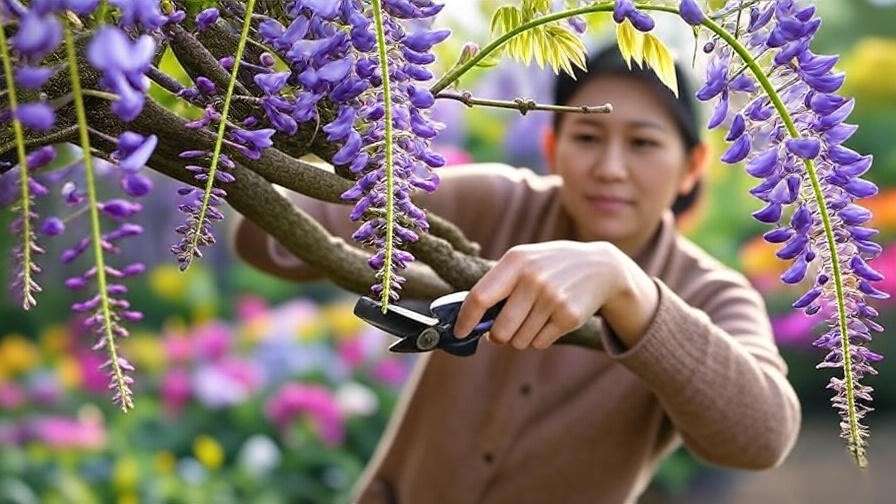
Pest and Disease Management
Wisteria trees are relatively hardy but can face issues:
- Common Pests:
- Aphids: Small, sap-sucking insects. Solution: Spray with neem oil or insecticidal soap.
- Scale Insects: Hard, immobile pests. Solution: Remove manually or use horticultural oil.
- Japanese Beetles: Chew leaves and flowers. Solution: Hand-pick or use organic traps. 🐞
- Diseases:
- Root Rot: Caused by overwatering or poor drainage. Solution: Improve soil drainage and reduce watering.
- Powdery Mildew: White coating on leaves. Solution: Apply fungicide and ensure good air circulation.
- Prevention: Regular inspections, proper spacing, and clean tools minimize risks.
Seasonal Care Calendar for Blue Wisteria Trees 📅
Caring for a blue wisteria tree requires tailored attention throughout the year to ensure its health and vibrant blooms. Below is a seasonal guide to keep your wisteria thriving:
- Spring 🌷:
- Tasks: Apply a high-phosphorus fertilizer to kickstart growth. Lightly prune to remove winter damage and shape the canopy. Monitor for early pests like aphids.
- Focus: Encourage strong bud development by ensuring adequate sunlight and water.
- Expert Tip: Check soil moisture weekly, as spring rains can lead to overwatering.
- Summer ☀️:
- Tasks: Water deeply during dry spells, aiming for 1-2 inches of water per week. Deadhead spent blooms to promote a second flush of flowers in some cultivars. Continue training young trees by securing new growth to supports.
- Focus: Maintain canopy shape and control vigorous growth.
- Expert Tip: Mulch around the base to retain moisture and keep roots cool.
- Fall 🍂:
- Tasks: Reduce watering as the tree prepares for dormancy. Inspect for damaged branches or signs of pests. Apply a 2-3 inch layer of organic mulch to protect roots from temperature fluctuations.
- Focus: Prepare the tree for winter while preserving its structure.
- Expert Tip: Avoid heavy pruning in fall to prevent stimulating new growth vulnerable to frost.
- Winter ❄️:
- Tasks: Perform heavy pruning in late winter to shape the tree and remove excess growth. Protect young trees from frost with burlap wraps if temperatures drop below -10°F.
- Focus: Maintain a dormant, healthy tree ready for spring growth.
- Expert Tip: Check stakes and ties to ensure they’re secure against winter winds.
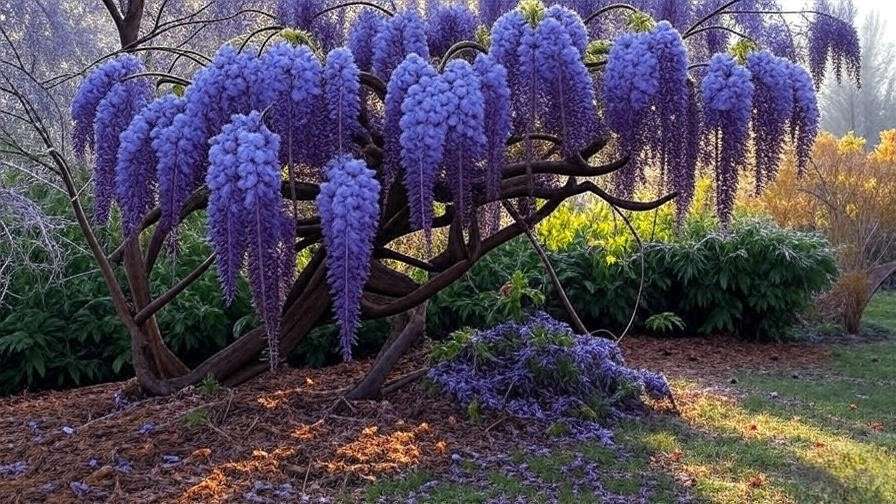
Design Ideas: Incorporating Blue Wisteria Trees in Your Landscape 🎨
Garden Design Inspiration
A blue wisteria tree can elevate your garden’s aesthetic with its cascading blooms and elegant form:
- Focal Point: Plant a wisteria tree in the center of a lawn or near a seating area to create a stunning centerpiece. Its vibrant flowers draw the eye and add drama.
- Companion Planting: Pair with low-growing perennials like lavender, roses, or clematis to complement its colors and fill space beneath the canopy. Avoid aggressive plants that compete for nutrients.
- Structural Uses: Train wisteria over pergolas, arbors, or trellises for a romantic, shaded retreat. A single tree can transform a patio into a cozy outdoor room.
Container Growing for Small Spaces
For urban gardeners or those with limited space, growing a blue wisteria tree in a container is a fantastic option:
- Choosing the Right Pot: Select a container at least 24 inches wide and deep with multiple drainage holes. Terra-cotta or heavy plastic pots provide stability.
- Care Adjustments:
- Water more frequently, as potted soil dries out faster.
- Use a high-quality potting mix with perlite or vermiculite for drainage.
- Prune regularly to control size and maintain tree shape.
- Expert Insight: Container-grown wisterias, like ‘Amethyst Falls,’ are ideal for patios or balconies but require sturdy support to prevent tipping. Repot every 2-3 years to refresh soil nutrients.
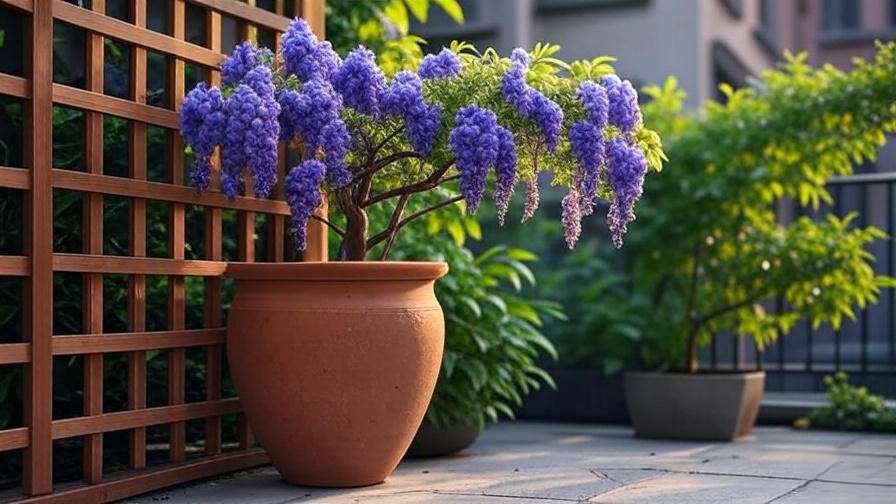
Troubleshooting Common Blue Wisteria Tree Problems 🛠️
Why Isn’t My Wisteria Blooming?
A non-blooming wisteria can be frustrating, but the issue is often fixable:
- Common Causes:
- Insufficient Sunlight: Less than 6 hours of sun reduces flower production.
- Improper Pruning: Cutting too much or at the wrong time removes flower buds.
- Nutrient Imbalance: Excess nitrogen promotes leaves over blooms.
- Young Age: Trees under 3-5 years may not yet be mature enough to flower.
- Solutions:
- Relocate to a sunnier spot or trim nearby plants blocking light.
- Follow the pruning schedule (late winter and post-flowering).
- Use a phosphorus-rich fertilizer (e.g., 5-10-10) to encourage blooms.
- Be patient with young trees, as some cultivars take time to establish.
Managing Invasive Growth
Wisteria’s vigorous roots and shoots can become invasive if unchecked:
- Control Methods:
- Install a root barrier (plastic or metal) 18-24 inches deep around the planting area.
- Regularly remove suckers and runners sprouting from the base.
- Prune long shoots to prevent them from spreading to unwanted areas.
- Expert Tip: Plant wisteria at least 10 feet from buildings, septic systems, or other plants to minimize root damage.
Dealing with Yellowing Leaves or Drooping Blooms
These symptoms often indicate underlying issues:
- Nutrient Deficiency: Yellow leaves may signal low iron or nitrogen. Solution: Apply a balanced fertilizer or chelated iron after a soil test.
- Overwatering: Soggy soil causes root rot and drooping. Solution: Improve drainage and reduce watering frequency.
- Disease: Powdery mildew or fungal infections can weaken the tree. Solution: Apply fungicide and improve air circulation through pruning.
- Expert Tip: Regularly inspect leaves and stems for early signs of distress to address issues promptly.
Expert Insights: Secrets to a Show-Stopping Blue Wisteria Tree 🌟
Horticulturists share advanced tips to maximize your wisteria’s potential:
- Advanced Pruning: Cut back last season’s growth to 2-3 buds in late winter to stimulate larger, more abundant blooms. This technique, known as spur pruning, focuses the tree’s energy on flowering.
- Success Story: A gardener in Zone 6 transformed a neglected wisteria vine into a thriving tree by staking it firmly and pruning twice yearly. Within three years, it produced cascades of blooms that became the talk of the neighborhood.
- Myth-Busting: Contrary to popular belief, wisteria trees don’t always need heavy fertilization. Overfeeding can lead to lush foliage but fewer flowers. Stick to a balanced approach.
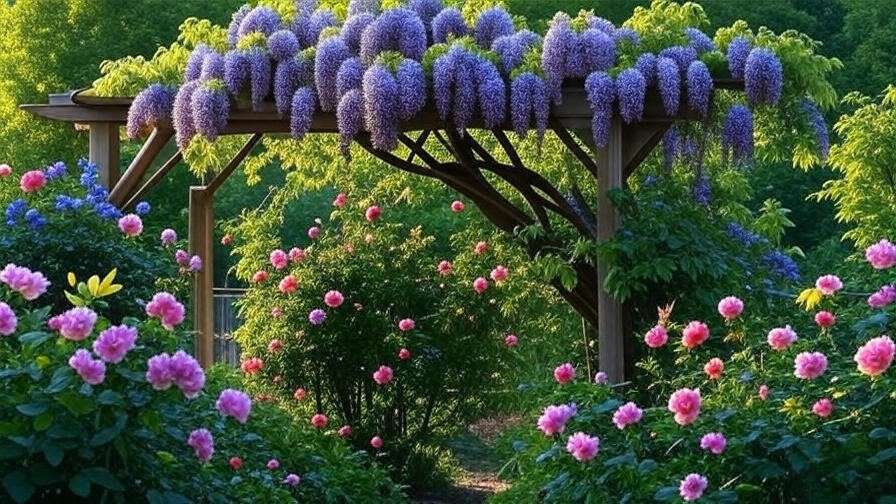
FAQs About Blue Wisteria Tree Care ❓
- How long does it take for a blue wisteria tree to bloom?
Most wisterias bloom within 3-5 years, though cultivars like ‘Prolific’ may flower sooner with proper care. - Can I grow a wisteria tree in a cold climate?
Yes, cultivars like ‘Blue Moon’ thrive in Zone 4, but protect young trees from harsh winter winds. - How do I prevent my wisteria from becoming invasive?
Use root barriers, prune regularly, and remove suckers to control growth. - What’s the best support structure for a wisteria tree?
A sturdy metal or wooden stake (6-8 feet tall) works well, paired with a trellis for canopy support. - Are blue wisteria trees safe for pets?
Wisteria seeds and pods are toxic to pets. Keep them out of reach and clean up fallen pods promptly.
Conclusion: Your Path to a Gorgeous Blue Wisteria Tree 🌸
Growing a blue wisteria tree is a rewarding endeavor that brings unparalleled beauty to your garden. By choosing the right location, planting correctly, and following a consistent care routine—watering, fertilizing, and pruning—you can enjoy cascades of vibrant blooms each spring. With the expert tips and seasonal strategies outlined in this guide, you’re equipped to overcome challenges like slow blooming or invasive growth. Start your wisteria journey today, and share your success stories in the comments below! For more plant care inspiration, explore our guides on ornamental trees and companion planting. 🌿

